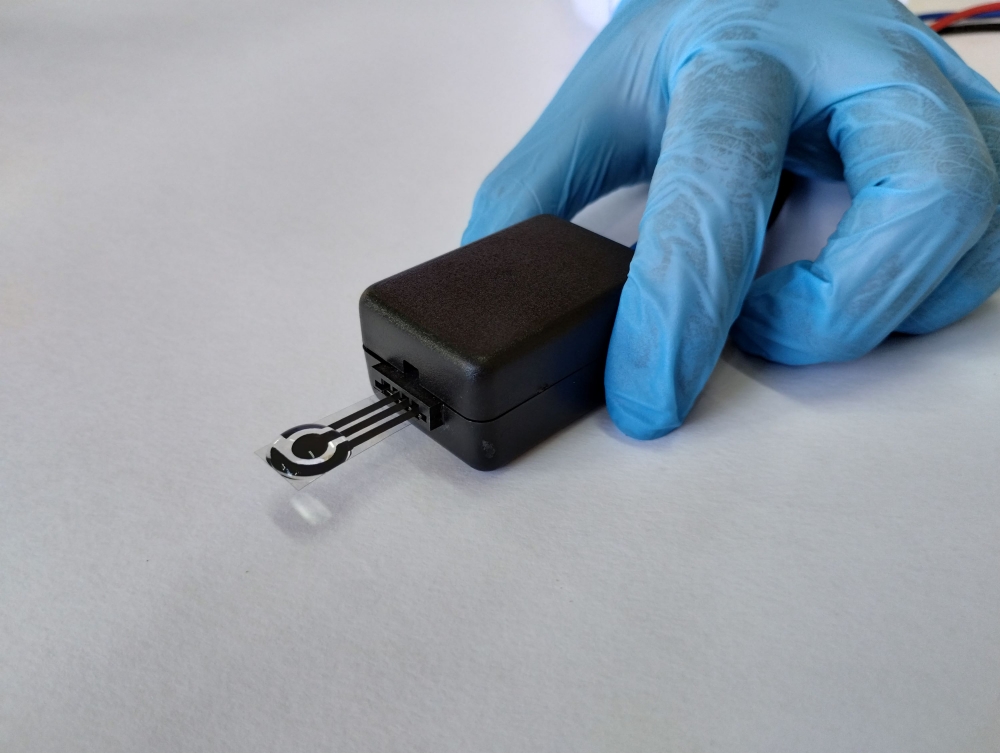

Developed at the University of São Paulo, the device permits corrections to the dosage of the analgesic to improve its efficacy according to the patient’s profile and avoid toxic side effects or overdose (photo: Paulo Augusto Raymundo Pereira)
Developed at the University of São Paulo, the device permits corrections to the dosage of the analgesic to improve its efficacy according to the patient’s profile and avoid toxic side effects or overdose.
Developed at the University of São Paulo, the device permits corrections to the dosage of the analgesic to improve its efficacy according to the patient’s profile and avoid toxic side effects or overdose.

Developed at the University of São Paulo, the device permits corrections to the dosage of the analgesic to improve its efficacy according to the patient’s profile and avoid toxic side effects or overdose (photo: Paulo Augusto Raymundo Pereira)
By Julia Moióli | Agência FAPESP – Consumption of medical drugs such as painkillers, antibiotics, antidepressants and antivirals is rising at breakneck speed. Sales of such drugs are set to reach USD 1.8 trillion worldwide by 2026. The trend reflects the aging of the global population and more frequent outbreaks of epidemic diseases. However, because these drugs are often prescribed in standardized dosages regardless of the patient’s metabolism, clinical conditions and nutritional health, they may fail to have the desired effects, and scientists and physicians are increasingly turning to personalized prescriptions.
With this strategy in mind, researchers affiliated with the University of São Paulo’s São Carlos Institute of Physics (IFSC-USP) and São Carlos Institute of Chemistry (IQSC-USP) in Brazil have developed a simple, cheap and flexible sensor that rapidly analyzes saliva to detect paracetamol, a widely used analgesic, and monitors its action in real time to permit dosage correction.
An article reporting the research is published in the journal Small: nano micro and featured on the frontispiece of the March 22 issue.
After administration of a single dose in an oral pill, electrodes on the surface of the device can detect the drug quickly and non-invasively in a small sample of human saliva, thanks to oxidation of the active ingredient by the sensors to produce an electric current.
“The protocol is promising for observation and correction of fluctuations in absorption of paracetamol and response to the drug,” said Paulo Augusto Raymundo Pereira, last author of the article and a researcher at IFSC-USP. “An imprecise dosage can have harmful effects not only on the treatment but also on the patient’s organism.”
Paracetamol (also known as acetaminophen) is the main non-opioid analgesic recommended for mild pain by the World Health Organization (WHO), but its excessive consumption is associated with liver and kidney problems caused by the accumulation of toxic metabolites, as well as gastrointestinal bleeding and anemia. According to the American Liver Foundation (ALF), paracetamol is the leading cause of liver failure in the United States, accounting for over 50% of all cases. Overdoses of the drug cause 458 deaths per year in the United States, according to studies of archives and databases; 100 are unintentional. The real number of health problems and hospitalizations is likely to be far higher. Specialists warn that a physician should always be consulted before taking any over-the-counter drug, above all if the patient has a history of liver or kidney disease, and the recommended dosage should always be followed.
“In addition, our methodology would also help reduce water contamination. Pills are often quite wrongly thrown away in the garbage, and some of the paracetamol ingested is not metabolized but excreted in urine. Wastewater treatment plants aren’t 100% efficient in removing pharmaceuticals,” said Nathalia Oezau Gomes, a chemist and co-author of the article.
Low cost
The research was supported by FAPESP (projects 16/01919-6 and 20/09587-8). The device was fabricated with a similar methodology to the silkscreen technique used to print T-shirts. A portion of conductive carbon paste was placed on a screen with the sensor diagram, under which lay a sheet of store-bought clear polyester transparency film. The paste was then dispersed with a squeegee.
The device is portable and uses low-cost sensors, each priced at less than USD 0.02 (two cents), far cheaper than comparable instruments used for this type of analysis, which are often bulky and require trained operators.
The choice of saliva for detection purposes also has advantages, such as ease of collection and the fact that saliva secretion reflects the level of free analytes (or sample components). Furthermore, like other non-invasive body fluids, such as sweat and tears, saliva is increasingly used in therapeutic drug monitoring thanks to the relatively low cost of collection, storage, shipping and processing in a central laboratory.
“The results of our study demonstrate the significant potential of a simple strategy,” Pereira said. “Low-cost electrochemical devices are increasingly seen as an attractive alternative for therapeutic drug monitoring thanks to their analytical characteristics, such as rapid response, potential miniaturization, portability, simplicity, ease of use, versatility, relatively low instrumentation cost, and the possibility of in situ real-time analysis.”
A prototype has been developed, with wiring, cables and connectors, and is ready for technology transfer to a future partner company interested in mass-producing and marketing the device. Next steps will include trials involving a larger number of volunteers and comparison of the data obtained with a gold-standard technique.
The article “On-site therapeutic drug monitoring of paracetamol analgesic in non-invasively collected saliva for personalized medicine” is at: doi.org/10.1002/smll.202206753.
Republish
The Agency FAPESP licenses news via Creative Commons (CC-BY-NC-ND) so that they can be republished free of charge and in a simple way by other digital or printed vehicles. Agência FAPESP must be credited as the source of the content being republished and the name of the reporter (if any) must be attributed. Using the HMTL button below allows compliance with these rules, detailed in Digital Republishing Policy FAPESP.





